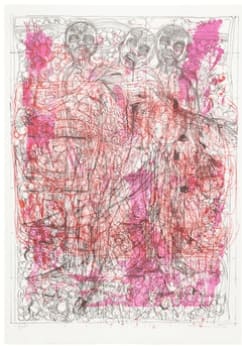Hermann Nitsch
Hermann Nitsch's work embodies deep contemplation on nature, human nature, death and resurrection, and mysticism. Nitsch combines visual art and performing arts to explore the inner world of individuals and raise questions about the essence of humanity. Inspired by the exceptional composer, Richard Wagner, Herman Nitsch presented extensive performance art for the acts of Wagner's "Die Walküre" during the Bayreuth Festival in 2021. In these transformative performances, the artist used up to 1000 liters of paint per act, depicting Wagner's melodies melting into his shades and colors.
-
 Ohne Titel, 2021
Ohne Titel, 2021 -
 Ohne Titel, 2021
Ohne Titel, 2021 -
 Schüttbild (Bayreuth Series), 2021
Schüttbild (Bayreuth Series), 2021 -
 Schüttbild (Bayreuth Series), 2021
Schüttbild (Bayreuth Series), 2021 -
 Schüttbild (Bayreuth Series), 2021
Schüttbild (Bayreuth Series), 2021 -
 Schüttbild (Bayreuth Series), 2021
Schüttbild (Bayreuth Series), 2021 -
 Aus der Serie "Die Architektur des Orgien Mysterien Theaters" Mappe lll, 1984/92
Aus der Serie "Die Architektur des Orgien Mysterien Theaters" Mappe lll, 1984/92 -
 Aus der Serie "Die Architektur des Orgien Mysterien Theaters" Mappe lll, 1984/92
Aus der Serie "Die Architektur des Orgien Mysterien Theaters" Mappe lll, 1984/92 -
 Ohne Titel (Schüttstein), 1984 - 1991
Ohne Titel (Schüttstein), 1984 - 1991
Hermann Nitsch (29th August 1938 Wien - 18th April 2022 Mistelbach) is one of the most famous international artists of the second half of the XX century. He is an exponent of the Wiener Aktionismus with Günter Brus, Otto Mühl and Rudolf Schwarzkogler that around the 60s become the major expression of the European Body Art movement.
At that time Nitsch - graduated at the Experimental Graphic Institute of Vienna - joined as a painter the tachiste movement that was based on the interpretation of the informal culture exalting the gesture through which the dripping colour is directly thrown on canvas.
From 1961 on, his actions, where a lamb is tore and its blood used as bleeding painting, became more regular and more articulated. Since 1962, men also got involved in his performances.










